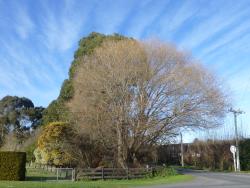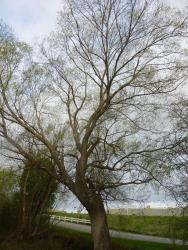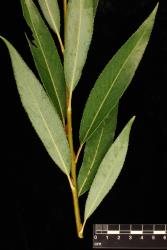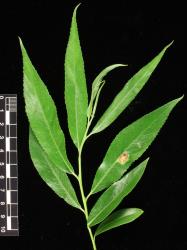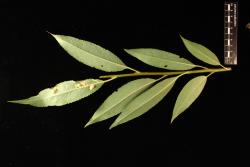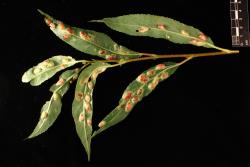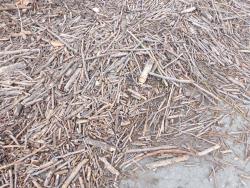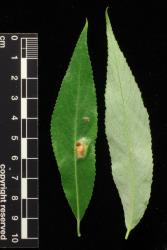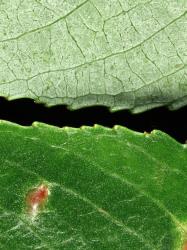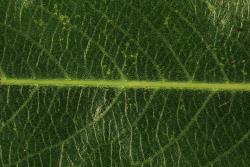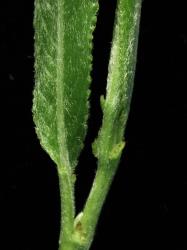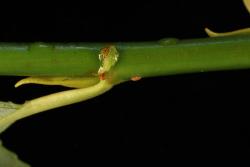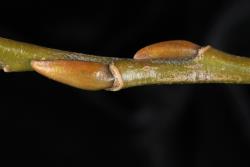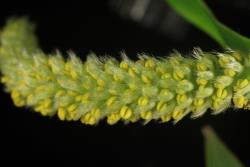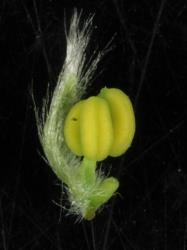- ≡ Salix fragilis L., Sp. Pl. 1017 (1753)
- = Salix ×rubens Schrank, Baier. Fl. 1, 226–227 (1789)
Trees with trunk or trunks up to 1 m diameter. Year-old branchlets arched outwards, olive-green (UCL125) to light olive (UCL106) to yellowish brown (UCL74). Flowering branch bud scales 8.0–9.5 mm long, 3.0–3.8 mm wide, ovoid, brownish orange. Stipule 1–7 mm long, very narrowly ovate. Petiole 9–30 mm long, glands absent or 2–3, brown or black, base of petiole pinky-red. Emerging leaves green. Leaf lamina 98–197 mm long, 19–48 mm wide, very narrowly ovate; leaf galls abundant, red, rarely blackish; upper leaf surface glabrous; lower leaf surface glabrous.
Catkins male, rarely female. Male catkin 43–63 mm long, 7–8 mm diameter. Male flower bract 1.7–3.0 mm long, 0.6–1.1 mm wide. Flowering female branch 30–62 mm long at flowering, extending to 140 mm when capsules are ripe, with 2–4 leaves + 1 cataphyll. Female catkin 25–70 mm long, extending to 100 mm long when capsules are ripe. Ovary 1.8–2.8 mm long, widening at the base as it matures, stipe extending to 0.6 mm long when capsules are ripe.
A tree varying in form from only ca. 8 m high with lower branches almost horizontal and a rather flat crown, to an erect, tall tree ca. 14 m high. Branchlets of lower branches arch outwards but are not vertically pendulous. Branchlets break easily or with difficulty, and the ground is often densely littered with branchlet pieces after strong winds. One-year-old branchlets vary in colour but are generally dark yellow or deep yellow to light olive (most often dark yellow). Leaves are narrowly ovate with a long, narrowly acuminate apex. Red sawfly galls are almost universally present. Rootlets when exposed on stream banks are pink to red. Leaves are sparsely long-silky haired on the under surface, particularly around the midvein and petiole, and glabrous or with a scattering of hairs on the upper surface. Leaves are usually, but not always, glaucous on the lower surface. It has a preference for wet habitats (stream banks, lake margins, swamps, ponds, backwaters, roadside ditches) but often planted in well-drained soils. Almost exclusively male in New Zealand.
A very variable hybrid with features of the two parents to varying degrees (Triest 2001). Triest (2001) did not make a distinction between Salix ×fragilis and S. euxina, but found that leaf and branchlet hairs vary in the hybrid from almost none to moderately dense on the leaf underside and sparse on the upper leaf surface. The underside of the leaf varies from not glaucous to distinctly glaucous. In the past, hybrids with morphology closer to the S. alba parent (denser hairs, glaucous) were referred to S. ×rubens (e.g. Sykes 1988), as have female plants, while hybrids with S. euxina morphology (few leaf hairs, not glaucous) were commonly referred to as S. fragilis (e.g. Sykes 1988). Variation also exists in branchlet colour, from red-brown to yellow-green, but branchlet colour is not preserved in dried specimens. Brittleness of branchlets also varies a great deal. Trees are variable in form. Trees in windy places develop a distinctive flat-topped tree shape, while trees in sheltered places develop an erect form and are difficult to distinguish from S. matsudana × S. alba.
Most similar to Salix alba and S. ×pendulina. As S. euxina is absent from New Zealand, the almost glabrous extreme of variation in S. ×fragilis is the easiest to identify. The hairy extreme of the variation is very difficult to distinguish from S. alba, as noted by Triest (2001).
Dried female plants of Salix ×fragilis f. fragilis are difficult to distinguish from S. ×fragilis f. vitellina as the golden branchlet colour of f. vitellina is lost on drying. The easiest way to distinguish the two is that f. fragilis ovaries swell at the base and develop into capsules, while the ovaries of f. vitellina do not swell at the base and do not develop into capsules. If catkins are not available on dried specimens the two formas are probably indistinguishable.
Very common throughout New Zealand, both wild and in cultivation as shade trees, shelterbelts, and plantings in public parks and gardens. Northland (Whangārei 1987), Auckland (Auckland City 2014, Milford 1979), Gisborne (Ōpōtiki 1975, Ngaruroro River 1950, Hastings 2013), Volcanic Plateau (Taumaranui 1964), Taranaki (New Plymouth 2018), Southern North Island (Whanganui City 2006, Kawhātau River 1995, Rangiwahia 1928, Tukituki River 1987, Masterton 1964), Sounds–Nelson (Motueka River 1995), Western Nelson (Ōpārara River 1985), Marlborough (Molesworth Station 1946, Fairhall 1982), Westland (St Arnaud 1998, Ahaura 1974, Lake Brunner 1978, Lake Kaniere 2016), Canterbury (Motunau 1974, Hurunui River 1963, Ashley River 1964, Lower Waimakariri River 1965–2020, Kaiapoi 1995, Christchurch City 1963–2020, Darfield 1965, Coalgate 1964, Hororata 1964, Greendale 1964, Coes Ford 1994, Rakaia Huts 1964, Ashburton River 1964, Ōpihi River 1963, Ashburton Lakes 1979, Washdyke 1963, Peel Forest 1984, Arowhenua 1964, Waimate 1966, Lake Pukaki 1969, Jollie River 1962, Mt Cook 1972, Ahuriri 2012), Otago (Clyde 1994, Wānaka 1968, Earnscleugh 1949, Kyburn 1966, Ranfurly 1975, Alexandra 1966, Rock and Pillar 1968, Palmerston 1966, Balclutha 1986), Southland (Te Anau 1977, Bluff 1969), Fiordland (Lake Monowai 1995), Stewart Island / Rakiura (Halfmoon Bay 1983, Butterfields Beach 1979), Chatham Islands (Rekohu 2019).
The most common wild willow in New Zealand. Salix ×fragilis is listed by the Ministry for Primary Industries on their National Pest Plant Accord list (it cannot be traded) and is an unwanted organism (Biosecurity NZ).
First collection: V. D. Zotov, 5 November 1928, roadside between Kimbolton and Rangiwahia, CHR 207.
First publication: Armstrong (1879) listed it as naturalised in Canterbury.
Flowering: Late September–mid-November. Flowers emerge later than those of the weeping willows (Salix ×pendulina) but before flowers of S. alba.
Tetraploid, but diploid and octoploid counts exist (2n = 76, 15 counts; 2n = 38, four counts; 2n = 114, three counts—CCDB).
Christensen & Jonsell (2005) and Brummitt et al. (2009) pointed out that the name Salix fragilis L. has been used for the species and hybrid, but most often for the hybrid, as this is much more common in Europe than the species described as S. euxina I.V.Belyaeva. Christensen & Jonsell (2005) proposed to conserve the name Salix fragilis L. for the species, but the Nomenclature Committee (Brummitt et al. 2009) voted against the proposal and asked Belyaeva to prepare a publication making the name S. fragilis apply to the hybrid by lectotypifying it using a specimen from the Celsius herbarium and publishing a new name for the species, S. euxina. Kuzovkina and Marchenko, in a communication to the Nomenclature Committee in 2020, questioned whether Linnaeus saw the specimen from the Celsius herbarium chosen as the lectotype and whether the epitype, which is missing, is the hybrid. They believed that Salix fragilis L. and S. ×rubens Schrank were names available for the species and hybrid, respectively, that no new names were needed, and that these two names should be used. Re-lectotypification of S. fragilis L. would be needed to make the name refer to the species rather than to the hybrid.



